Downward-Facing Dog Pose
One of yoga's most widely recognized poses, Adho Mukha Svanasana strengthens the core and improves circulation, while providing a delicious, full-body stretch.
Heading out the door? Read this article on the new Outside+ app available now on iOS devices for members! Download the app.
Adho Mukha Svanasana (Downward-Facing Dog Pose) is one of yoga’s most widely recognized poses. This foundational pose opens and strengthens the shoulders and chest, lengthen the hamstrings, and improves circulation with a full-body stretch.
“Adho Mukha Svanasana was the first asana I fell in love with, and it remains my desert island pose,” says Natasha Rizopoulos, a senior teacher and teacher trainer with Down Under School of Yoga. “When you’re tired, staying in this pose for a spell will restore your energy. It can also help strengthen and shape your legs, ease shoulder stiffness, and slow your heartbeat. I find it the perfect microcosm of yoga practice: It requires both strength and flexibility; it teaches you to appreciate alignment, and thus prepares you for doing inversions, backbends, and forward bends; and it offers philosophical lessons, such as the cultivation of stability and spaciousness, that will carry over into the rest of your life.”
“Downward Dog is the perfect pose to observe and correct your body’s imbalances,” adds Annie Carpenter, founder of SmartFLOW Yoga. “For some people, this pose is about stretching and opening; for others, it’s learning to stabilize your joints with muscular effort.” In this way, Downward Dog cultivates full-body strength and flexibility with intention and ease.
Sanskrit
Adho Mukha Svanasana (AH-doh MOO-kah shvah-NAHS-ah-nah)
adho = downward
mukha = face
svana = dog
How to do Downward-Facing Dog Pose
- Come onto your hands and knees. Bring your hands slightly in front of your shoulders, pread your fingers wide, press down through your knuckles, and tuck your toes.
- Exhale as you lift your knees and reach your hips up and back. Keep your knees slightly bent as you press the backs of your thighs toward the wall behind you and reach your heels toward the mat.
- Press the base of your index fingers into the mat. Relax your neck and keep your head between your upper arms.
- Breathe here. As you exhale, bend your knees and lower yourself into Child’s Pose
Downward-Facing Dog Variations
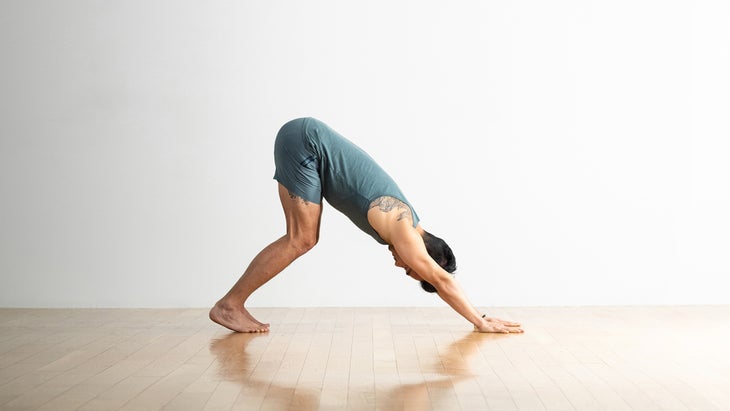
Bent-Knee Downward Facing Dog
If your hamstrings feel tight or you experience low back pain, bend your knees a little or a lot. This can also help if you feel a strain in your lower back.
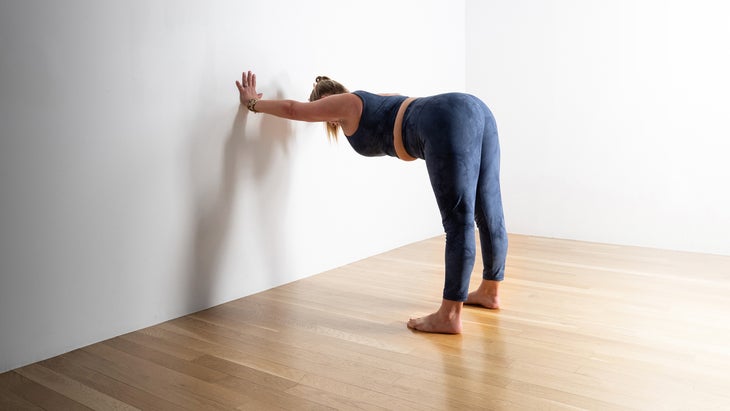
Downward Facing Dog Against a Wall
Bring your hands to the wall, shoulder-distance apart, and walk your feet back so your hips bend at 90 degrees. Your hands can be in line with your hips or higher on the wall. Look straight down at the floor.
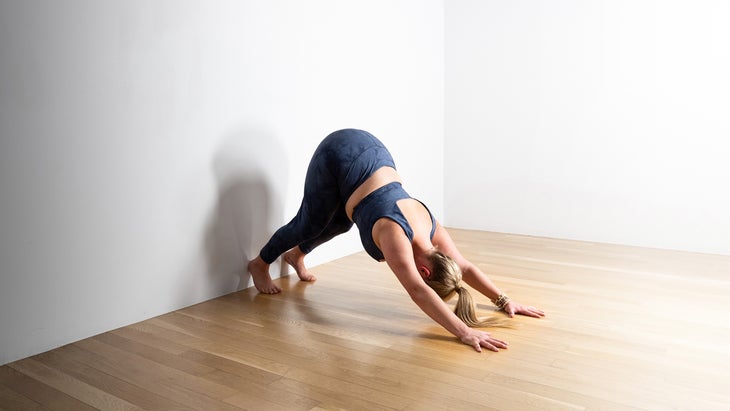
Downward Facing Dog With Heels Against a Wall
If you have tight hamstrings, bring your heels against a wall and keep a slight bend in your knees. Rest your heels against the wall. If you’re in a class, you can keep a rolled blanket at the back of the mat and use that as support for your heels.
Downward-Facing Dog Pose Basics
Pose type: Inversion
Targets: Lower Body
Benefits: Perhaps the most widely recognized yoga posture, Downward-Facing Dog Pose (Adho Mukha Svanasana) is equal parts strengthening and stretching. It strengthens your wrists, arms, and shoulders; it stretches your wrists, hamstrings, and entire back body.
Because the posture lengthens your spine, it counteracts the effects of prolonged sitting and improves posture. Although it’s a common pose, it’s not an easy one. It can take time, practice, and continual readjustments, and not just in your body.
Beginner Tips
- Keep your knees bent if you experience strain or tightness in your hamstrings and low back.
- Let your heels feel heavy as you let them sink toward the mat. It’s perfectly okay and quite common for them to remain lifted off the mat.
- Reach your sit bones toward the wall behind you where it meets the ceiling.
- If you have tight shoulders, place your hands slightly wider than your shoulders and turn your fingers slightly outward.
Common Misalignments
- If you have stiff shoulders or hamstrings, Down Dog may feel exceptionally challenging. Tight shoulders can cause you to round your back or shift your body too far forward in the pose. Lift your hips and press your chest toward your thighs to help your arms and back form a long straight line.
- If you’re flexible or hypermobile, you’ll want to bring awareness to your shoulders to avoid collapsing. Push the mat away from you and draw your shoulders blades away from your ears. Allow some space between your shoulder blades.
Why We Love Downward-Facing Dog Pose
“I’ve had two mind-blowing revelations while practicing this pose. The first was when a teacher ever-so-gently put her thumb and forefinger between my shoulder blades and opened them. Such a small adjustment opened my shoulder blades and moved my hunched shoulders away from my ears,” says Tamara Jeffries, Yoga Journal‘s senior editor.
“The second revelation was while watching a video of Laruga Glaser doing an Ashtanga series. She entered the pose by lifting her hips, not pushing through the arms. Now I lift into the pose, rather than push up into it. It makes a world of difference in how I approach my Dog.”
How to Teach Down Dog
- Remind students to notice if they’re hyperextending their elbows. You can cue them to keep a microbend in their elbows or suggest they press their inner upper arms away from one other until they can feel the biceps engage.
- Rizopoulos likes to remind students of the parallels between practicing this pose and being human. “As you find the alignment of this pose, see if you can find alertness and relaxation in the rest of your life. Too often in our daily lives these two qualities exist in opposition. On the yoga mat, however, we can learn to inhabit them simultaneously.”
Preparatory and Counter Poses
Warm up for Adho Muka Svanasana with stretches for the hamstring and spine. You can follow Down Dog with almost any pose, although if you find yourself exhausted afterward, let yourself sink into Child’s Pose.
Preparatory Poses
Uttanasana (Standing Forward Bend)
Counter Poses
Anatomy
Adho Mukha Svanasana is part arm balance, part inversion, and part restorative pose that stretches and strengthens various parts of the body, explains Ray Long, MD, a board-certified orthopedic surgeon and yoga instructor.
In the drawings below, pink muscles are stretching and blue muscles are contracting. The shade of the color represents the force of the stretch and the force of contraction. Darker = stronger.
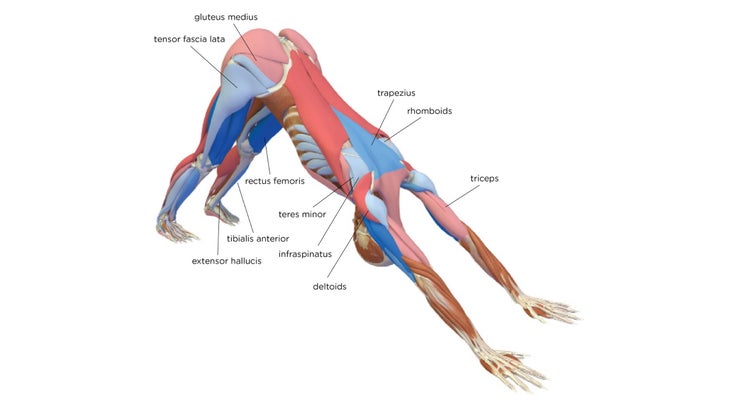
Press the mounds at the base of your index fingers into the mat to engage your forearms. The internal rotation this creates in the forearms, combined with the external rotation in your shoulders, creates a “wringing” effect in your arms and increases stability. When you straighten your elbows, you contract the triceps.
When you activate the quadriceps, this stretches and relaxes the hamstrings. As you draw the tops of your feet toward the fronts of your shins, you activate the tibialis anterior muscles, which in turn relaxes and lengthens the gastrocnemius/soleus complex along your calves and allows your heels to drop toward the mat.
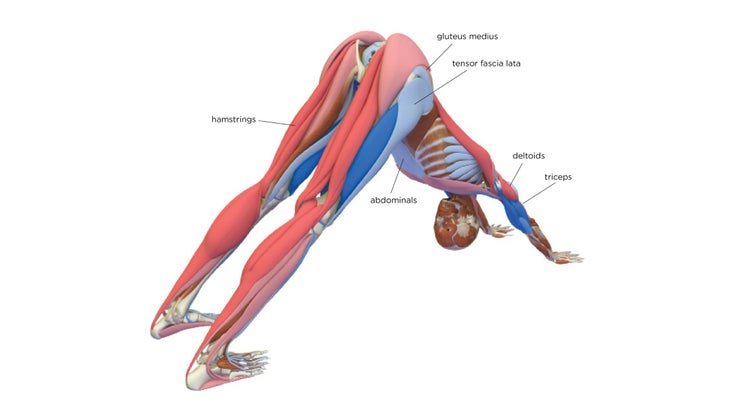
As you lengthen through the back to extend the lumbar spine, you contract the quadratus lumborum and erector spinae muscles along the spine as well as the psoas muscle. These actions flex your hips which creates the movement of the chest toward the thighs. These muscles also tilt the pelvis forward into anteversion. The tile of the pelvis and the flexion at your hips draws the origin point of the hamstrings, the ischial tuberosities (aka sit bones), upward. This stretches the hamstrings. To further stretch the hamstrings, engage the quadriceps to produce reciprocal inhibition, further relaxing them.
Excerpted with permission from The Key Poses of Yoga and Anatomy for Vinyasa Flow and Standing Poses by Ray Long.
Cautions & Contraindications
Avoid this pose if you suffer from an injury to your wrists, shoulders, or ankles, or if you have high blood pressure.
Downward-Facing Dog Pose in Practice
Down Dog is a pose you will return to again and again in your practice, as it is often a pose that is practiced as a transition between standing poses and floor poses, such as in Sun Salutations and other yoga flows.
- Your Step-by-Step Guide to Flowing Through Surya Namaskar A
- Find Your Flow With This Kripalu Sequence
- A Calming Yoga Sequence to Help You Slow Down
Section divider
About Our Contributors
Teacher and model Natasha Rizopoulos is a senior teacher at Down Under Yoga in Boston, where she offers classes and leads 200- and 300-hour teacher trainings. A dedicated Ashtanga practitioner for many years, she became equally as captivated by the precision of the Iyengar system. These two traditions inform her teaching and her dynamic, anatomy-based vinyasa system Align Your Flow. For more information, visit natasharizopoulos.com.
Ray Long is an orthopedic surgeon and the founder of Bandha Yoga, a popular series of yoga anatomy books, and the Daily Bandha, which provides tips and techniques for teaching and practicing safe alignment. Ray graduated from the University of Michigan Medical School and pursued post-graduate training at Cornell University, McGill University, the University of Montreal, and the Florida Orthopedic Institute. He has studied hatha yoga for over 20 years, training extensively with B.K.S. Iyengar and other leading yoga masters, and teaches anatomy workshops at yoga studios around the country.